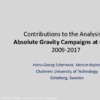Scherneck H.-G. i M. Rajner. „Contributions to the Analysis of Absolute Gravity Campaigns at Onsala 2009-2017”. , nkg 2018, (Geodesy in a Dynamic World — Celebrating 100 year anniversary of fgi).
- [bib]
@conference{2018_Scherneck_nkg,
}title = {Contributions to the Analysis of Absolute Gravity Campaigns at Onsala 2009-2017}, author = {Scherneck, Hans-Georg and Rajner, Marcin}, eventtitle = {nkg 2018}, eventtitleaddon = {Geodesy in a Dynamic World — Celebrating 100 year anniversary of fgi}, venue = {Pasilan virastokeskus}, presenter = {Marcin Rajner}, eventdate = {2018-09-03/2018-09-06}, date = {2018-09-05}, year = {2018}, month = {sep}, - [streszczenie]
We report on efforts to provide reduction data for AG campaigns using the SG GWR054. Instead of g-software reduction for tides etc., the basic idea is to subtract low-pass filtered SG data (even at the the exact drop times, eventually supplemented with accelerations from a broadband seismometer). Thus, AG data could be reduced for a wider range of secular effects in gravity variation; and we alleviate limitations of the representation of tides and loading effects in g-software. The AG-SG reduction comprises all campaigns (with FG-220(X) from IfE Hannover and FG-233(X) from Lantmäteriet) from 2009 to 2017 in a single adjustment, aiming at the determination of . The crucial point here is to accurately determine the drift of the SG. A range of solutions from tide analysis employs different strategies that affect in particular the long-period domain. The station is located near the coast of the semi-enclosed basin of Kattegat, which urges us to carefully separate long-term effects from atmosphere and sea level. Finally we report on the determination of the SG scale factor and the time delay in the SG’s signal chain. The scale factor can be determined in each AG campaign separately, and a long-term value can be obtained from the multi-campaign adjustment. A third value was obtained from a campaign with the GAIN quantum gravimeter from Humboldt University Berlin in 2015. We can show that the latter, comprising three weeks of operation, provides the lowest post-fit uncertainty, the scale value being compatible with the multi-campaign result, while individual campaigns result in a wide scatter of the estimates. Concerning timing we used a teleseismic P-wave from an almost-antipodal event recorded by the broadband seismometer at 100 S/s, matched a numerical representation of the GGP filter and adjusted for a remaining delay. We think the timing result is precise to within 0.1 s.
